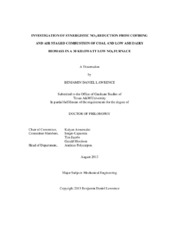| dc.description.abstract | Alternate, cost effective disposal methods must be developed for reducing phosphorous and nitrogen loading from land application of animal waste. Cofiring coal with animal waste, termed dairy biomass (DB), is the proposed thermo-chemical method to address this concern. DB is evaluated as a cofired fuel with Wyoming Powder River Basin (PRB) sub-bituminous coal in a small-scale 29 kW_(t) low NO_(x) burner (LNB) facility. Fuel properties, of PRB and DB revealed the following: a higher heating value of 29590 kJ/kg for dry ash free (DAF) coal and 21450 kJ/kg for DAF DB. A new method called Respiratory Quotient (RQ), defined as ratio of carbon dioxide moles to oxygen moles consumed in combustion, used widely in biology, was recently introduced to engineering literature to rank global warming potential (GWP) of fuels. A higher RQ means higher CO_(2) emission and higher GWP. PRB had an RQ of 0.90 and DB had an RQ of 0.92. For comparison purposes, methane has an RQ of 0.50. For unknown fuel composition, gas analyses can be adapted to estimate RQ values.
The LNB was modified and cofiring experiments were performed at various equivalence ratios (phi) with pure coal and blends of PRB-DB. Standard emissions from solid fuel combustion were measured; then NO_(x) on a heat basis (g/GJ), fuel burnt fraction, and fuel nitrogen conversion percentage were estimated. The gas analyses yielded burnt fraction ranging from 89% to 100% and confirmed an RQ of 0.90 to 0.94, which is almost the same as the RQ based on fuel composition. At the 0.90 equivalence ratio, unstaged pure coal produced 653 ppm (377 g/GJ) of NOx. At the same equivalence ratio, a 90-10 PRB:LADB blended fuel produced 687 ppm (397 g/GJ) of NO_(x). By staging 20% of the total combustion air as tertiary air (which raised the equivalence ratio of the main burner to 1.12), NO_(x) was reduced to 545 ppm (304 g/GJ) for the 90-10 blended fuel. Analysis of variance showed that variances were statistically significant because of real differences between the independent variables (equivalence ratio, percent LADB in the fuel, and staging intensity). | en |


